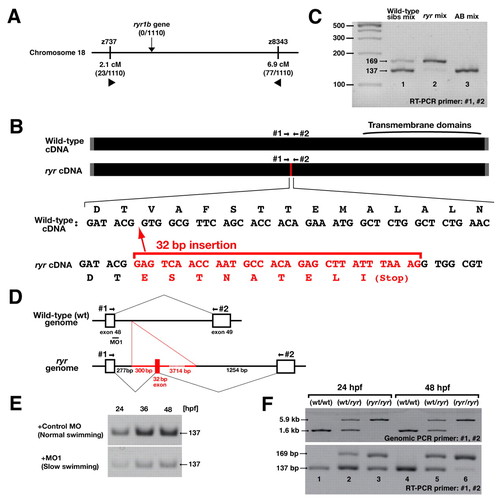
ryr mutant embryos have a mutation in ryr1b due to a DNA insertion that leads to aberrant splicing of ryr1b mRNA. (A) Meiotic mapping placed the ryr locus between z737 and z8343 in chromosome 18. No recombination was found with a polymorphic marker in the ryr1b gene (0/1110). (B) ryr mutants contained a 32-bp insertion (red) in ryr1b mRNA that added a nonsense codon 5′ to the transmembrane domains. (C) Reverse transcriptase (RT)-PCR using primers #1 and #2 (see B) amplified both a longer mutant band (169 bp) and a shorter wild-type band (137 bp) from a group of wild-type siblings (lane 1), whereas the mutant band was predominant in ryr mutants (lane 2). The wild-type band can be seen faintly in the mutant lane. Only the shorter band was amplified from wild-type AB embryos (lane 3). (D) ryr mutants carry a 4046-bp insertion (red) in the intron between exons 48 and 49 of ryr1b that includes the additional 32-bp sequence found in the mutant cDNA. (E) Injection of an antisense morpholino (MO1, see D) into recently fertilized wild-type embryos effectively decreases normal ryr1b mRNA at 24, 36 and 48 hpf, whereas control MO does not. A fragment of normal ryr1b mRNA was examined by RT-PCR with primers #1 and #2 (see D). (F) Genomic PCR and RT-PCR with primers #1 and #2 using individual embryos as a template. Genotypes, as shown, were identified by genomic PCR. Notice that, in mutants, the intensity of the wild-type (short) band amplified by RT-PCR was comparable to that of the mutant (long) band at 24 hpf (lane 3) but was diminished at 48 hpf (lane 6).
|

